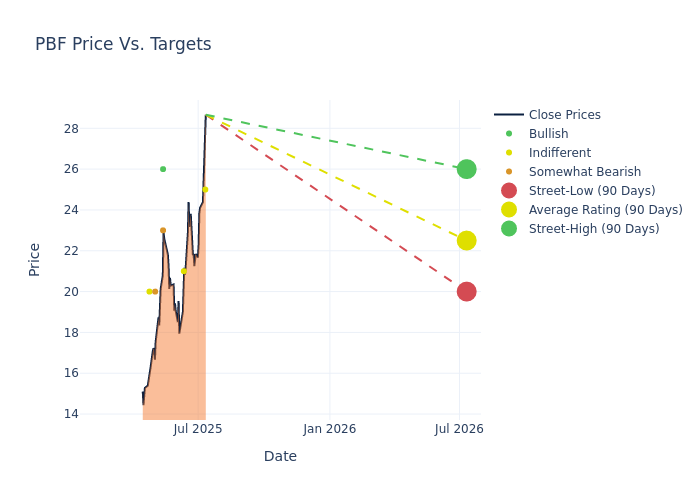Expert Outlook: PBF Energy Through The Eyes Of 7 Analysts
In the last three months, 7 analysts have published ratings on PBF Energy (NYSE:PBF), offering a diverse range of perspectives from bullish to bearish.
The table below summarizes their recent ratings, showcasing the evolving sentiments within the past 30 days and comparing them to the preceding months.
| Bullish | Somewhat Bullish | Indifferent | Somewhat Bearish | Bearish | |
|---|---|---|---|---|---|
| Total Ratings | 1 | 0 | 4 | 2 | 0 |
| Last 30D | 0 | 0 | 1 | 0 | 0 |
| 1M Ago | 0 | 0 | 1 | 0 | 0 |
| 2M Ago | 1 | 0 | 0 | 1 | 0 |
| 3M Ago | 0 | 0 | 2 | 1 | 0 |
In the assessment of 12-month price targets, analysts unveil insights for PBF Energy, presenting an average target of $21.86, a high estimate of $26.00, and a low estimate of $18.00. This upward trend is evident, with the current average reflecting a 2.68% increase from the previous average price target of $21.29.

Analyzing Analyst Ratings: A Detailed Breakdown
The standing of PBF Energy among financial experts becomes clear with a thorough analysis of recent analyst actions. The summary below outlines key analysts, their recent evaluations, and adjustments to ratings and price targets.
| Analyst | Analyst Firm | Action Taken | Rating | Current Price Target | Prior Price Target |
|---|---|---|---|---|---|
| Paul Cheng | Scotiabank | Raises | Sector Perform | $25.00 | $16.00 |
| Roger Read | Wells Fargo | Raises | Equal-Weight | $21.00 | $18.00 |
| Nitin Kumar | Mizuho | Raises | Underperform | $23.00 | $22.00 |
| Manav Gupta | UBS | Raises | Buy | $26.00 | $20.00 |
| Roger Read | Wells Fargo | Lowers | Equal-Weight | $18.00 | $22.00 |
| Ryan Todd | Piper Sandler | Lowers | Underweight | $20.00 | $23.00 |
| Connor Lynagh | Morgan Stanley | Lowers | Equal-Weight | $20.00 | $28.00 |
Key Insights:
- Action Taken: Analysts frequently update their recommendations based on evolving market conditions and company performance. Whether they 'Maintain', 'Raise' or 'Lower' their stance, it reflects their reaction to recent developments related to PBF Energy. This information provides a snapshot of how analysts perceive the current state of the company.
- Rating: Analyzing trends, analysts offer qualitative evaluations, ranging from 'Outperform' to 'Underperform'. These ratings convey expectations for the relative performance of PBF Energy compared to the broader market.
- Price Targets: Analysts explore the dynamics of price targets, providing estimates for the future value of PBF Energy's stock. This examination reveals shifts in analysts' expectations over time.
For valuable insights into PBF Energy's market performance, consider these analyst evaluations alongside crucial financial indicators. Stay well-informed and make prudent decisions using our Ratings Table.
Stay up to date on PBF Energy analyst ratings.
Delving into PBF Energy's Background
PBF Energy Inc is an independent petroleum refiner and supplier of unbranded transportation fuels, heating oil, petrochemical feedstocks, lubricants, and other petroleum products in the United States. The company owns refineries in Delaware, Ohio, New Jersey, California, and Louisiana. The Company operates in two reportable business segments: Refining and Logistics. The Company's oil refineries are all engaged in the refining of crude oil and other feedstocks into petroleum products and are aggregated into the Refining segment. PBFX operates logistics assets such as crude oil and refined products terminals, pipelines and storage facilities. The Logistics segment consists solely of PBFX's operations.
Unraveling the Financial Story of PBF Energy
Market Capitalization: With restricted market capitalization, the company is positioned below industry averages. This reflects a smaller scale relative to peers.
Revenue Challenges: PBF Energy's revenue growth over 3M faced difficulties. As of 31 March, 2025, the company experienced a decline of approximately -18.27%. This indicates a decrease in top-line earnings. When compared to others in the Energy sector, the company faces challenges, achieving a growth rate lower than the average among peers.
Net Margin: PBF Energy's financial strength is reflected in its exceptional net margin, which exceeds industry averages. With a remarkable net margin of -5.69%, the company showcases strong profitability and effective cost management.
Return on Equity (ROE): PBF Energy's financial strength is reflected in its exceptional ROE, which exceeds industry averages. With a remarkable ROE of -7.54%, the company showcases efficient use of equity capital and strong financial health.
Return on Assets (ROA): PBF Energy's ROA falls below industry averages, indicating challenges in efficiently utilizing assets. With an ROA of -3.12%, the company may face hurdles in generating optimal returns from its assets.
Debt Management: The company maintains a balanced debt approach with a debt-to-equity ratio below industry norms, standing at 0.61.
The Significance of Analyst Ratings Explained
Analysts work in banking and financial systems and typically specialize in reporting for stocks or defined sectors. Analysts may attend company conference calls and meetings, research company financial statements, and communicate with insiders to publish "analyst ratings" for stocks. Analysts typically rate each stock once per quarter.
Beyond their standard evaluations, some analysts contribute predictions for metrics like growth estimates, earnings, and revenue, furnishing investors with additional guidance. Users of analyst ratings should be mindful that this specialized advice is shaped by human perspectives and may be subject to variability.
Breaking: Wall Street's Next Big Mover
Benzinga's #1 analyst just identified a stock poised for explosive growth. This under-the-radar company could surge 200%+ as major market shifts unfold. Click here for urgent details.
This article was generated by Benzinga's automated content engine and reviewed by an editor.